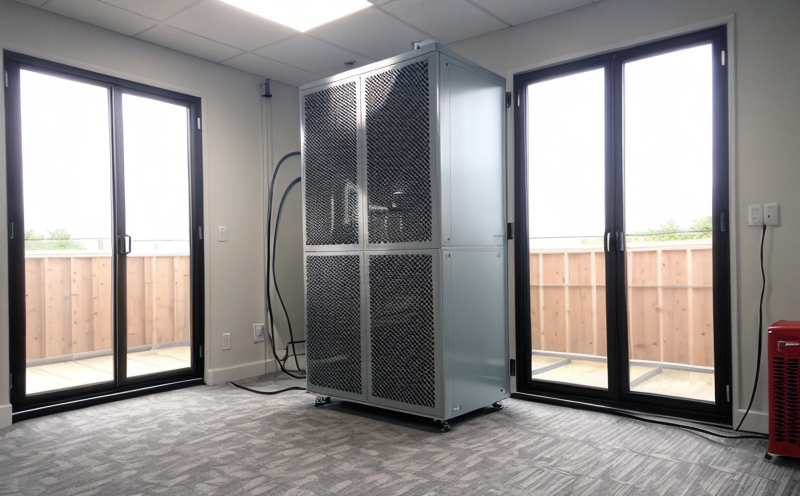Laboratory Airflow Pattern Check
The Laboratory Airflow Pattern Check is a critical service offered by our laboratory specializing in HVAC equipment testing. This service ensures that the airflow within ventilated spaces adheres to design specifications and meets regulatory standards, thereby enhancing comfort, safety, and energy efficiency.
Our process involves the systematic examination of air movement patterns within various components of HVAC systems. This includes ducts, grilles, diffusers, and other elements that contribute to the overall airflow dynamics. The goal is to identify any discrepancies between the intended airflow distribution and actual performance. By doing so, we help clients maintain optimal indoor environments, which are crucial for health, productivity, and comfort.
The first step in our process is an initial assessment of the HVAC system’s design documents and operational parameters. This helps us understand the expected air flow rates and pressure differentials. Next, we conduct a series of tests using advanced instrumentation to measure airflow velocity, direction, and volume at multiple points within the system. We also employ computational fluid dynamics (CFD) simulations where necessary to validate our findings.
Once all measurements are taken, our team analyzes the data to determine if there are any deviations from the design specifications. If issues are identified, we provide a detailed report outlining these discrepancies along with recommendations for corrective actions. This comprehensive approach not only ensures compliance but also helps in optimizing system performance and extending its lifespan.
Our laboratory adheres strictly to international standards such as ISO 19245-2:2018 for HVAC airflow testing, ensuring that our results are reliable and valid across different regions.
Why It Matters
The importance of proper airflow cannot be overstated in the context of HVAC systems. Incorrect airflow can lead to several problems including reduced energy efficiency, increased noise levels, discomfort for occupants, and even potential health hazards. Inadequate ventilation can result in poor indoor air quality (IAQ), leading to respiratory issues among building occupants.
From an operational perspective, ensuring correct airflow patterns is essential for maintaining equipment integrity over time. Poorly designed or poorly maintained HVAC systems may experience increased wear and tear due to uneven load distribution, which could lead to premature failure of components like fans, motors, and dampers.
In terms of sustainability, efficient HVAC systems contribute significantly towards reducing energy consumption in commercial buildings. By identifying and rectifying airflow issues early on, we help our clients achieve better IAQ while minimizing resource use and operational costs. This aligns perfectly with broader sustainability goals set forth by organizations like LEED (Leadership in Energy and Environmental Design).
Moreover, compliance with local regulations and industry best practices is crucial for avoiding legal penalties and maintaining good standing within the community. Regular airflow checks are often mandated by authorities to ensure public health and safety.
Benefits
- Enhanced Indoor Air Quality: Properly balanced airflow ensures that pollutants, odors, and other contaminants are effectively removed from the space.
- Increased Energy Efficiency: Optimized airflow reduces the workload on HVAC equipment, leading to lower energy bills and reduced CO2 emissions.
- Improved Comfort Levels: Consistent temperature distribution throughout the building results in more comfortable environments for occupants.
- Prolonged Equipment Lifespan: Correctly maintained airflow prevents excessive strain on mechanical components, extending their useful life span.
- Regulatory Compliance: Ensures adherence to relevant codes and standards, avoiding potential fines or penalties.
Environmental and Sustainability Contributions
The importance of sustainable practices cannot be overlooked when discussing HVAC systems. Efficiently designed and operated HVAC networks play a pivotal role in reducing carbon footprints by minimizing energy consumption. By conducting thorough airflow pattern checks, we assist our clients in achieving their environmental goals while simultaneously enhancing operational efficiency.
Our laboratory’s commitment to sustainability extends beyond just testing; it involves educating our clients about best practices for optimizing HVAC performance. We encourage the use of renewable energy sources wherever possible and advocate for smart building technologies that integrate real-time data analytics into decision-making processes.
Through these efforts, we contribute significantly towards creating healthier, more productive workplaces while also supporting global initiatives aimed at combating climate change. Our dedication to sustainability aligns closely with our mission statement: providing not just services but solutions that make a difference.





